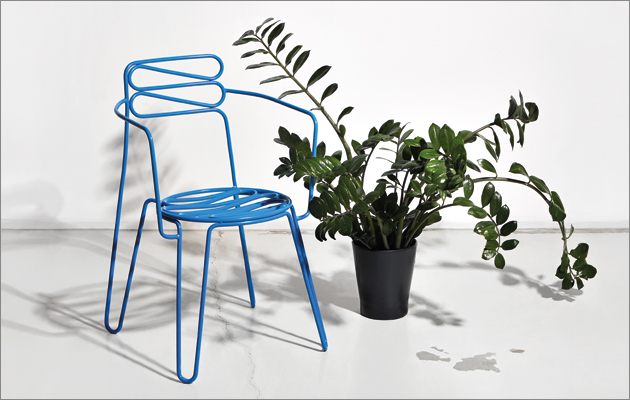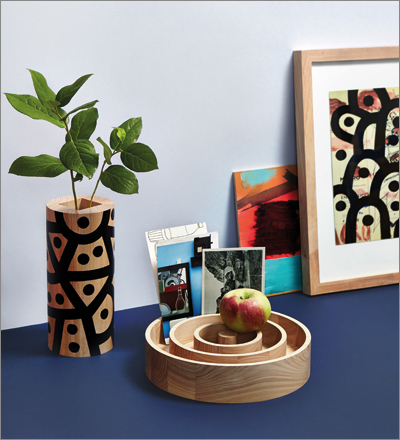|
|
||
|
Often inspired by line drawings, the French-born designer’s works have established her as a leading light of Warsaw’s emerging design scene In terms of their production methods, the two projects that Warsaw-based designer Maria Jeglinska exhibited last year at Aram’s London Design Festival exhibition, Future Stars?, could not provide a starker contrast. Drawn Objects is a series of toy-like waxed ash vessels, hand-turned and then painted by Jeglinska with bold acrylic patterns. The Little Black, on the other hand, is a prototype for a collection of cafe chairs and tables constructed from squiggles of painted steel, soon to be produced on an industrial scale by Polish manufacturer Meble Vox for its new, still unnamed brand. Inspired by the cafe revival currently percolating in Warsaw, the Little Black’s wire form harks back to a vernacular typical of outdoor furniture between 1955 and 1965, a period of uncharacteristic relaxation both within the Communist regime, and of its stifling grip on design, which resulted in a brief flourishing of creative output in the country. “The aim of this collection was to recreate – in a utopian way – the essence of what could have been a Polish design identity,” Jeglinska explains. Sitting in the French-born designer’s studio – a converted apartment that she shares with fellow members of Warsaw’s now thriving creative community – it’s clear that what links these two projects is drawing. Alongside works by key Polish poster artists such as Henryk Tomaszewski, Maria’s own expressive, pattern-based paintings crowd her desk, many executed on newspaper when she was too broke to afford anything else. |
Words Laura Snoad
Portrait Małgorzata Turczyska
Above: Jeglinska in her Warsaw studio
Images: Bartosz Stawiarski; Turczynska for Culture |
|
|
||
|
Little Black outdoor chair, 2014 |
||
|
These drawings are not just a key part of Jeglinska’s thought process, they also act as visual research for new projects, such as the surface design for her ceramics range for Kristoff – her first project after she moved to Warsaw to set up her studio in 2012. “Drawing is like a muscle you need to train,” says Jeglinska. “You need a certain regularity or routine to produce good work.” The connection between conceptual thinking and mark-making was something that germinated during her education at Switzerland’s ECAL, where Jeglinska was tutored by Ronan Bouroullec and Pierre Charpin – both big drawers themselves. While there, she developed Circles – two simple, line-based tables constructed from a series of steel profiles that grow in diameter. This work, and the upholstered spiral stool Goodie, were put into production by Ligne Roset – both explore the functionality of basic geometric forms and “the idea of constantly reducing, refining and trying to find the essence of a project”, an approach largely inspired by her time under Bouroullec.
Drawn Objects in ash and acrylic paint, 2014 Since setting up her own studio, curation has been a significant focus of Jeglinska’s practice, no doubt relating back to her internship at Paris’s Galerie Kreo in 2007 and 2008, where she worked on the shows of numerous former tutors. Her recent Wonder Cabinets of Europe, first exhibited at LDF in 2012, invited six designers (as well as herself and co-curator Livia Lauber) to showcase their methodologies in units inspired by 16th-century cabinets of curiosity, and she recently designed two exhibitions for the city-wide Warsaw Under Construction, which addressed how artists in Poland’s capital have influenced wider social trends and the process of emancipation in the years after Communism. Jeglinska was initially concerned that moving her studio to Warsaw might close doors elsewhere in Europe, but in fact it’s had the opposite effect, giving her a certain “exoticism” in the UK while also opening her up to the fledgling Polish design industry, which stands on the cusp of huge transformation. “In the UK it’s understood that design is of value, whereas here people don’t really get it,” explains Jeglinska. “But it also means that there’s still so much to do here. It’s not so much about finding a niche – you can have a big impact.”
Wonder Cabinets of Europe, 2012 A more detailed look at Poland’s design and architecture scene will be in Icon’s June issue, out in early May |
||























